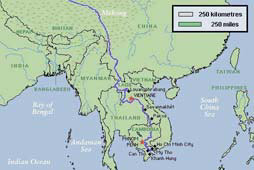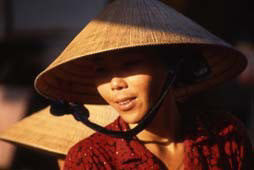
 Vietnamese woman
Vietnamese woman
 Vietnamese woman
Vietnamese womanThis week, a month after leaving the Mekong Delta, I reached the third country on my journey upriver – Laos. From the last town in Cambodia I hired a boatman to take me to the border in one of the narrow motorised canoes that the fishermen use. At first the riverside was well-populated, and naked children would skip and jump on the shore, waving and shouting their hellos. Then the houses petered out and trees took over. A kingfisher flashed blue in the morning sunlight. A statuesque heron glared at me from a sandbank. The boatman weaved and twisted his canoe around rapids, whirlpools, unseen eddies and the occasional vicious-looking rock. Already in February the dry season is well underway, and soon the Mekong will become barely navigable until the monsoon arrives in June.
The boatman dropped me at the border and quickly disappeared downstream. A few miles ahead, I knew I would come face to face with the cataracts that dashed the dreams of the early French explorers of a trade route up the Mekong to China. Wider than both Victoria and Niagara, the Khone Falls first announce their presence as a distant rumble, then as spray rising above the treetops, and finally a thunderous foaming torrent pouring over jagged rocks. After much heart-searching, the French bypassed this overwhelming obstacle with a short railway – the only one ever built in Laos – but the hoped-for trade never materialised and the jetties and locomotives stand derelict and rusting in the forest.
Like every other northbound traveller for
the last 50 years, I hitch-hiked round the falls to Siphandone,
‘the 4,000 Islands’, where local people have created
a little Shangri-La. On the island of Don Deth, which has no electricity
and no cars, I sat on the old railway bridge and watched the setting
sun blaze against a backdrop of date palms, before sleeping in
a bamboo guest house to the sound of rippling water. If any of
you are looking for that ultimate getaway experience, Don Deth
is definitely the place to go.
